When I bought Murisaki the dress form, something exciting happened. The proprietor of the Asia Gallery said “Oh, you might like these as well” and showed me these:
Ooooooh…..
And then he gave them to me. For free!
Squee!
(They like me. I buy a lot of stuff).
Now, my Japanese is limited to what I remember of high school Japanese after a dozen+ years. So what I know about these is based on what I can tell from the images.
At first I thought it was a dress catalogue, and a packet with one commercial pattern and a homemade pattern for tabi socks. Then I looked at it closely and realised that the pattern has ALL the dresses – every single child and adult dress shown in the catalogue – all drawn over each other ready for you to break your brain over as you sort them out.
Based on the style of the dresses I’d say the patterns are from 1951/52. There are dozens, and dozens of them, and even illustrations of fabrics. I’ll show you all the images in a number of posts over the next few weeks, but here are a few fabric designs and dresses for starters.
First the fabric designs:
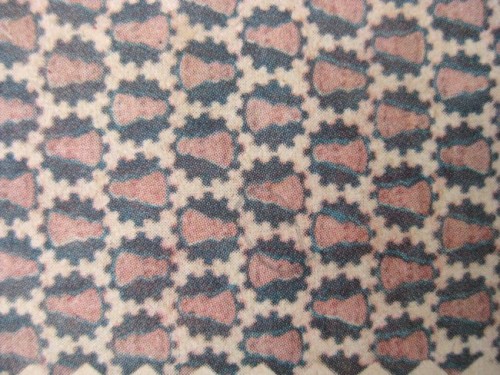
Look at the adorable little old-fashioned girls in their cog-circles! It's like Crinoline Lady goes steampunk, with pink AND black.
And then the dresses:
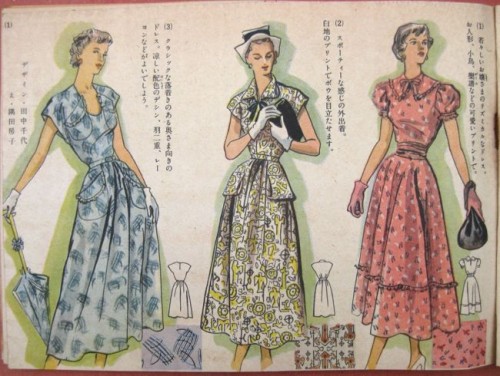
Darling dresses, with more darling fabric designs - little birdcages, something weird & Aztec, and musical notes on pink.
Notice how the pattern book, being Japanese, reads from the ‘back’ and from right to left.
One day I may even attempt to unsort and copy the patterns, brave the total lack of instructions I can read, and make some of these up!

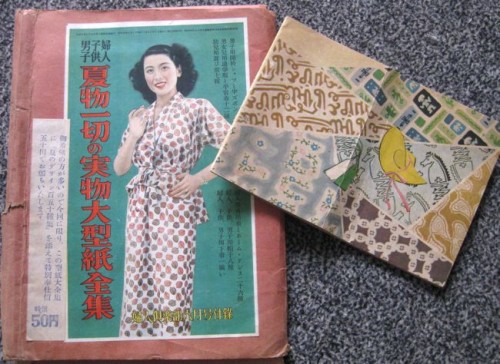

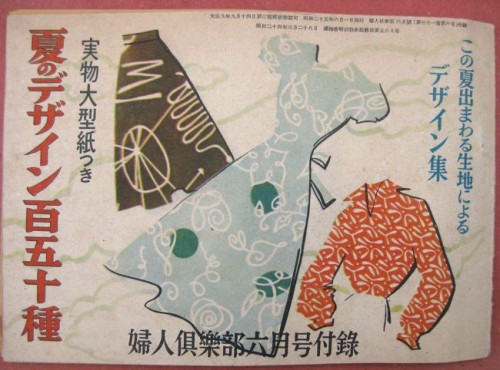
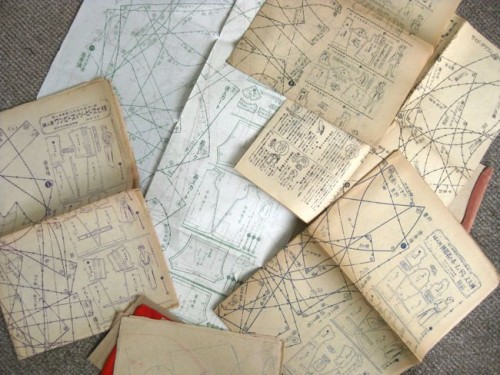
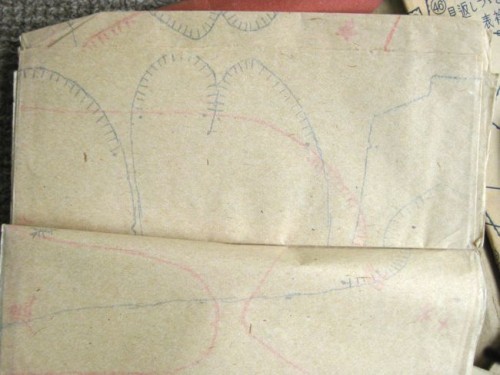
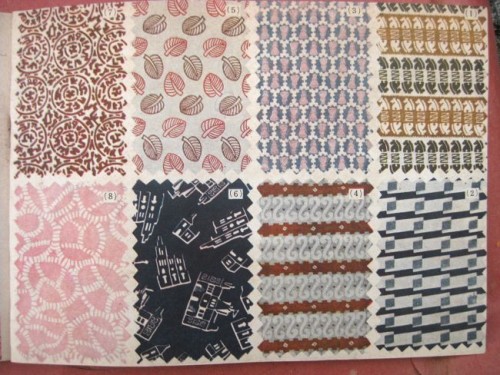

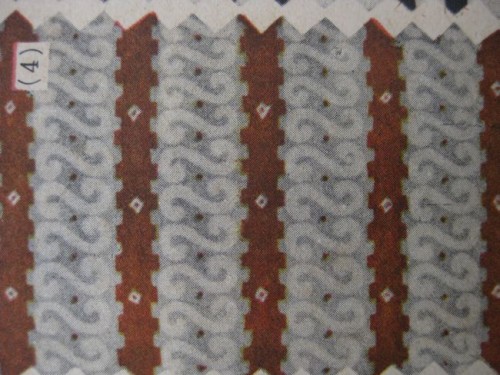
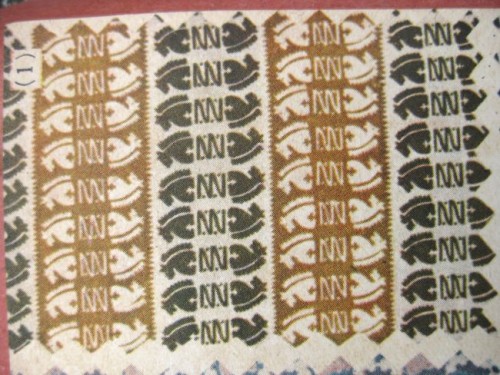
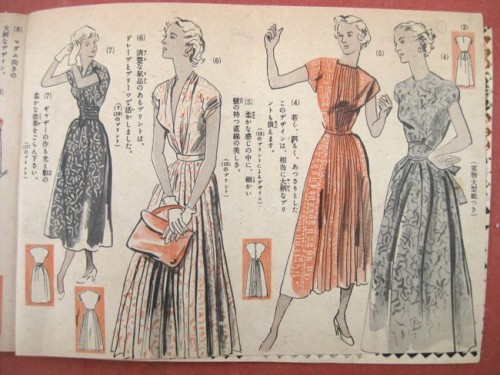
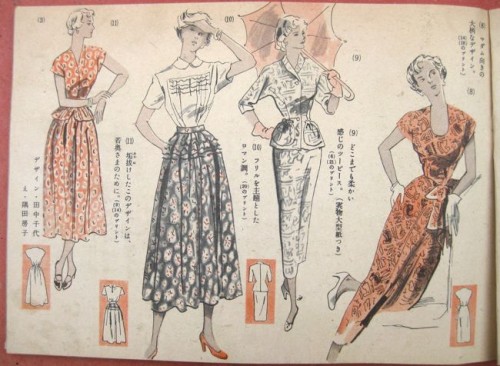
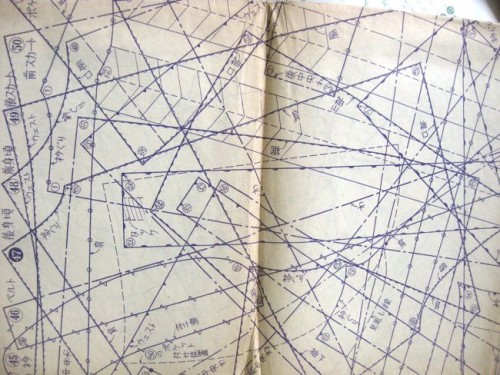
Oh dear… I love those dresses, but if I ever thought of using one of those patterns and saw THAT I would fall over dead. I feel like this would be one of those evil problems to pop up in calculus. “Find the rate of change of every single increasing and decreasing angle, then find the acceleration as the various movements sucks you into the page, never to be free again. Good luck. Oh, and translate cryptic Japanese.”
Haha! I never made it to calculus, but the patterns definitely have evil potential in plenty!
These are pretty fabulous! How lovely of them to give it to you for free!
I have a few yofuku (Western clothing) sewing books from the 40’s, 50’s and early 60’s that I’m slowly scanning in – but rather than coming with the pattern insert to trace like these ones, you draft the patterns based on measurements. This probably works by numbers – look for the number assigned to the outfit – and it will probably match up to the pattern pieces. I think with your sewing skills, you’ll easily be able to make these outfits!
I also adore the fabric prints! I wonder what the legalities would be of reproducing them. I know for paper ephemera, at least, many things prior to 1961 are in public domain (unless controlled by an estate in the case of an artist like Junichi Nakahara, for example). I bet you could reproduce for personal use, at least!
Oh, how interesting that you draft the pattern based on measurements – I’ve seen a few examples of that in the west.
I’ve definitely figured out it is a matter of matching numbers on illustrations and pattern pieces.
I’m wondering about the legalities of the prints and patterns too. I’ll have to do a bit more research into that. My knowledge base is all in fine arts.
Oh, what a gift!
It can’t be all that worse than the 30s-40s German pattern magazines I have borrowed from my aunt… I can understand German, some of it at least, but the instructions provided are about as scarce as what you will be able to deduce from these. So – good luck!
I’m not worried about the lack of instructions as much as their combination with the overlapping pattern pieces. How will I know if I missed something out!
It’s like Burda magazine patterns. I’ve never tried to work one out but people do. Lovely garments, although a little sad and a reminder of the pervasive and insidious influence of the West that the illustrations are all of Pakeha women, not Japanaese women…
Spoonflower time? 🙂 Maybe we can do a range of Welly fabrics on Spoonflower for the shop…
I noticed all the blond blue eyed women in the patterns too. Those girls would have had issues trying to feel beautiful if they are told to aspire to western looks! Those over lapping patterns would have me taking my pencil and poking my eye out!
Oh…and I’m sure those patterns don’t come in several sizes. After you traced out the pieces you’d have to redo them so you could get something that fit! (Watch me run, screaming down the street pulling my hair out…one eye poked out!)
I’ve already anticipated that fun-ness. I’m sure they aren’t remotely my size!
It’s like Burda magazine patterns. I’ve never tried to work one out but people do. Lovely garments, although a little sad and a reminder of the pervasive and insidious influence of the West that the illustrations are all of Pakeha women, not Japanaese women…
Spoonflower time? 🙂
Exactly. And having experienced a Burda magazine pattern, I’m not keen to try that again anytime soon! I always wondered if we should call them Pakeha if they aren’t actually New Zealanders of European descent.
While there was certainly a pressure to look ‘Western’ in Japan from the 1920s onwards, it may just be that some of the illustrations for this magazine came from an Western catalogue.
I use the term Pakeha correctly, and as it comes from my language, I find it natural to use it. I like it more than European, which has a specificity that is largely inaccurate and therefore relies on context. The term Pakeha with its inference of non-indigenousness I feel is an apt fit in this situation. 🙂
Is Pakeha like Haole? Do you speak many languages, Mrs C?
Hi Elise, Leimomi can probably answer that better than me as she would understand the full nuances of the words Haole and Pakeha. I love how words from other languages are often untranslatable by another single word, and even a paragraph of words can’t really nail the concept. Which is why I say it is part of my language, as a NZer, because I use Maori words, phrases etc as part of my vocab, it being the language of my country, if not my first language. Anyway sorry for getting off the topic of these gorgeous patterns! 🙂
Right! Patterns! (They are scary–but the results look sooooo beautiful!)
Pakeha is like Haole, and isn’t.
Mrs C uses Pakeha to mean anyone white, but I’ve always been taught that it specifically meant a white New Zealander. When you fill out official forms where they ask your ethnicity one of the main options is “Pakeha (New Zealander of European descent)”. Certainly historically it very specifically meant British European in NZ, and a different term (Tauiwi – lit. ‘Outsiders’/’Different people’ if I recall correctly) was used for other groups, such as the French. It definitely doesn’t have the slight connotation of ‘outsider’ that comes with haole.
There are urban myths about all the unpleasant things that Pakeha means, but none of them make sense linguistically, or appear earlier than the 1980s. Apparently the word comes from tales of a supernatural being with pale skin that comes out of the sea backwards (as you would in a rowboat) (Mermaids!). So pakeha doesn’t/shouldn’t have the pejorative connotations that come with haole, but I still know people who object to being called pakeha (interestingly, I just had a lengthy conversation with a group of people about this), and native te reo Maori speakers who won’t use it.
Wow. I had no idea I remembered so much from university classes and three years of te reo lessons!
Hmmm…according to Wikipedia it turns out we are both right.
Well I guess if I really had to articulate it, Pakeha for me means white, and not indigenous in context . But not in a pejorative way, just in a ‘definition’ way. So seeing these models so clearly white and also not indigenous Japanese, it feels very equivalent to me 🙂
Wow, what a wonderful find. The fabrics are lovely.
Yikes. Good luck with that. I refuse to even contemplate sorting out all those patterns.
What a fascinating artifact. Number 6 is my favourite too.
You must have excellent taste. 😉
Wow! What a great find..
It will take time but I would invest in these and trace the patterns. I’m sure you will know how to sew them up with out the English translation, given your sewing expertise.
I love the fabric swatches…love the 50’s..
I’m definitely hoping to find time to trace these out. There is just always so much else to do!
This is a wonderful thing! A real treasure. I once made a Burda pattern back in the 1960s, and once was enough, even though it was a nice little suit. Much heavy breathing as I followed the lines.
I think my favourite is the dress with the Aztec print. Okay, it would need a string bean to wear it. And the wee suit, number 9. The prints! Love them.
MrsC, I owe you! Spoonflower? Never heard of it! So I googled it, and wow!! The possibilities! I have dreamed of something like this. Fun will be had, even if most of it is day-dreaming. Thank you!
I helped someone with a Burda pattern once, and it was NOT FUN, so I know what I’m looking forward to if I ever tackle this! The Aztec dress is adorable – I think it might be surprisingly flattering on a lot of figures.
And isn’t Spoonflower fantastic? Soooo expensive if you order from NZ though.
Just thinking – this is probably one of those questions that expects the answer, ‘Of course’, but do you have a tracing wheel? Old-fashioned beastie, but it is the tool for the job here.
I’m an old fashioned beastie myself, so of course I have a tracing wheel 😉 I would prefer not to use it for this though, because I don’t want to damage the pattern, since it is in such lovely pristine condition.
What is a Burda pattern? And why is it hard? Sorry–I’m not a sewing noob…but definitely several (many many) classes behind you guys!
Burda Catalogue patterns come with folded pages that have all the patterns drawn on to one piece of paper in different colour, all over the top of each other – just like these. I’d never know what they were (rarely buying patterns) unless I had a friend who buys them.
I think they are a lot cheaper than normal patterns, but it still doesn’t make sense to me – you’d have to want to make every single one of the patterns for the price reduction to pay off! And be really, really patient, with a lot of spare time!
Sorry for all the word clarification! I obviously love words, but mostly it’s because I want to follow along to these cool discussions!
I wonder if burda patterns were especially popular in times of paper-shortage. As a kid in Canada, tales of WWI and II were different than what I had learned in the US, and we knew that British kids had to use ALL the paper–including the margins, and in very small print–in school.
I can only imagine what it was like in Japan after the war. After spending time in Germany, I think I can imagine something, though. My grandfather-in-law actually married a Japanese nurse in the early 50s, but the US refused to acknowledge the marriage, and she died while he was in the US petitioning to bring her over.
All this makes me wonder about the pattern, and the ink, along with what the designer was wanting to communicate with the clothing and fabric designs.
Lucky you and what great inspiration! #5 really speaks to me, perhaps with a square neckline and knee-skimming hem….
LOVELY fabrics. I’m drawn to the cute little leafy design.
ohhh! just oooohhhhhhhhhhhhh!
What lovely designs – but rather you than me when it comes to tracing out those patterns! (But I’d love to see the results if you ever do try making one of the dresses.)
I will certainly share anything I sew up. And look into making easier-to-work-with variants available to the public if that is possible 🙂
those fabrics are adorable!
ah sorting out patterns and instructions in other languages. I’ve done some japanese patterns. always a little frustrating to work out. first time I tried a japanese pattern I ended up cutting out a piece and not realising till after it was cut that I was supposed to trace it…….
Oh wow! What a lovely gift!
This looks fascinating but wow – lots of work! I hope you enjoy puzzles…
speaking from my experience of modern japanese fashion/sewing magazines – they’re still exactly the same! all the pieces of a whole book’s worth of outfits drawn over and under each other on one or two pattern pages. it’s a complete nightmare, but you do get the eye for it after the first one or two
good luck if you attempt any of them!
What a beautiful gift! It’s too bad you can’t just write the company and order up those fabrics anymore. I’ve been thinking about getting the Burda magazine, but the idea of tracing off of that complicated street-map looking thing is scaring me.